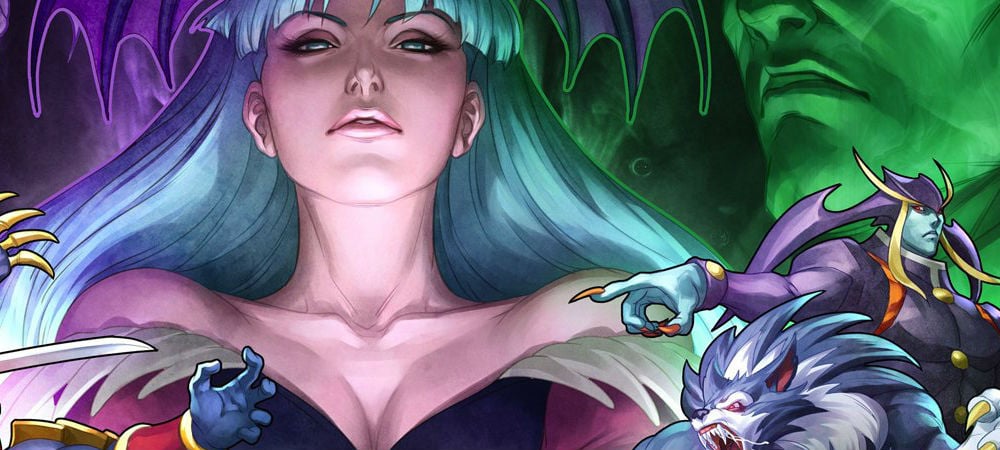Resurrection is the perfect term
Although Darkstalkers may not be the most popular franchise in the world, it holds a deep legacy for many fighting game fans. It contains one of the most unique and interesting stables of fighters in the entire genre, with great gameplay to boot.
When it was made known that Darkstalkers would once again return to consoles after a long hiatus, many people were concerned that its relevance would falter alongside all of the other more contemporary fighters on the market.
Thankfully, that legacy has been faithfully upheld with Darkstalkers Resurrection, and I’m here to tell you that it’s still absolutely relevant.

Darkstalkers Resurrection (PlayStation 3, Xbox 360 [reviewed])
Developer: Iron Galaxy Studios
Publisher: Capcom
Released: March 13, 2013
MSRP: $14.99 (1200 MSP)
I spent many long nights battling it out with the Darkstalkers games. There are very few fighters that encourage me to play nearly every character on the roster, but due to the intoxicating designs the franchise offered, I had to oblige.
With Darkstalkers Resurrection, I felt that magic all over again. For those of you who aren’t familiar with the package, this XBLA and PSN release contains two games — Night Warriors: Darkstalkers Revenge (1995) and Darkstalkers 3 (1997) — the the second and third games in the franchise, respectively.
The main menu starts you off with Darkstalkers 2, but you can switch between 2 and 3 with the select/back button, and the transition only takes a few seconds.
There are crisp and smooth graphical filters, with the option for classy scan lines and different screen views, which are mostly variations of looking into arcade cabinets. On the whole, however, the visuals are not nearly as upgraded as they could be for a re-release.
Make no mistake, although Iron Galaxy Studios makes the claim that the game is in “HD,” it still very much looks like an old-school fighter. Since the art style still holds up, I’m perfectly ok with how it looks currently — it’s just something to be aware of and it may be jarring at first if you’re expecting completely redrawn art.

In the main menu there’s a nice overview of fighting terms like “OTG” and “cross up,” which is a neat little way for casual fans to become more educated on the genre. The biggest addition is character-specific challenges and tutorials, which help new players learn the ropes, and specific combos and strategies like cancelling that will spill over into other fighters.
There’s also a really cool optional feature to display mini challenges on the side bars (like “throw the enemy x amount of times”), to make even menial battles fun. After you complete these, you can level up and unlock extras like concept art. It’s nice way to get people to diversify their strategy a bit, learn more, and get rewarded in the process.
The series’ six-button system (three punches, three kicks) is pretty easy to learn, as are the relatively low amount of commands — although mastering some of the more intricate combos will take loads of time. Capcom states that it left the two games unchanged from the Arcade version, balance-wise, and from what I can tell, that claim is accurate.
Both games are fast and furious, and are among the most “turbo”-feeling games on the market, which can make them hard to pick up at first. Combos and cancels are extremely fluid, but if you’re playing on the 360 controller, you may have issues doing some of the game’s harder combos without a fight stick.
Somehow, all of the game’s characters are oozing with personality, which is reason enough to take notice of the franchise and go in completely blind. Each and every fighter makes their own mark on the game and is utterly unique. My old mains are Demitri, Jedah, and Morrigan, but I found myself falling in love with old characters all over again.

Vampire Savior has the biggest cast of all the franchise, but sadly, this is the arcade version through and through, which means a lot of the extra console-specific characters are nowhere to be found. It’s a huge shame, and one of the biggest negatives in the package.
If you’re opting to play online, the netcode is extremely solid, and I had a chance to play around 50 games with little to no interruptions or issues. The GGPO-powered online system works just as advertised, and with eight-player lobby support, YouTube upload functionality, and an online tournament mode, Resurrection really shines online.
Although the visuals deserved a much larger upgrade than a lazy filter, the fact of the matter is, the engine still holds up amazingly well, and the netcode is near perfect.
If you’ve always been curious about this franchise, now is the time to take the plunge — if you’re a fan of old-school 2D fighters, you won’t be disappointed.





Published: Mar 15, 2013 05:00 pm